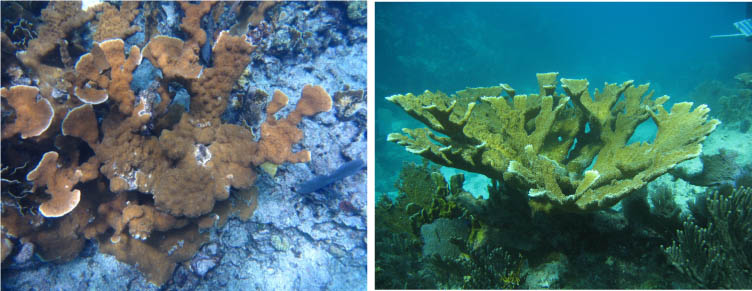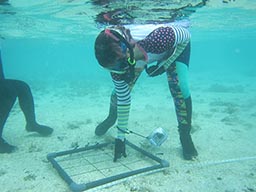- ABOUT US
- PROGRAM AREAS
- CONSERVATION APPROACH
- EDUCATION
- MULTIMEDIA
Discovery of "Coral Zombies" Present New Challenges to Coral Recovery
By Sable Liggera, Communications Intern
The discovery of "coral zombies" in reefs thought to be healthy has stunned scientists and coral recovery efforts.
Although once two of the most abundant coral species in the Caribbean, elkhorn (Acropora palmata) and staghorn (Acropora cervicornis) coral have both seen drastic decreases in population within the last four decades. A recent study led by NOAA's Cheryl Woodley offers insight into one of the causes behind this phenomenon.
Woodley's study assessed the reproductive health of 34 elkhorn coral populations throughout the U.S. Caribbean by studying the condition of their reproductive tissues. The researchers determined that while a large number of coral colonies initially appeared healthy to the naked eye, a significant number had no ova or spermaries and many other colonies had ova and spermaries that were not viable to reproduce. These corals were dubbed "coral zombies" — the living dead, because their populations are unable to sexually reproduce the next generation. Without intervention, their inability to reproduce prevents recovery and eventually leads to their death.

The number of "coral zombie" was found to vary from location to location. Sites with the highest number of reproductively impaired coral tended to have heavy human traffic. For example, corals at two popular tourist destinations off the Florida Keys were found to have no reproductive tissues. Meanwhile, two remote and less visited sites off the coast of St. John, U.S. Virgin Islands and Puerto Rico had coral populations with 80–100 percent of their reproductive tissues.
As the reproductive capabilities of elkhorn corals can vary widely depending on location, it is thought that the causes of "coral zombies" also vary from location to location. While the specific causes behind the reproductive failure of these corals remain unknown, mounting evidence implicates poor water quality and endocrine disrupting pollutants, such as personal care products and some antifoulant paints containing tributyl tin. It is clear corals exposed to multiple stressors are much more likely to become "zombies".
A coral reef exposed to pollution in addition to the side—effects of climate change, for example, will have a greater chance of having "coral zombies" than a site that is managed and protected from pollution. As such, the greatest weapon in preventing "coral zombies" is working to reduce the amount of stressors on reefs as much as possible. Colonies that are capable of healthy reproduction need to be increasingly protected, while impaired populations need to be investigated to determine the cause(s) behind "coral zombies" and what preventative measures can be taken.
About Us

The NOAA Coral Reef Conservation Program was established in 2000 by the Coral Reef Conservation Act. Headquartered in Silver Spring, Maryland, the program is part of NOAA's Office for Coastal Management.

The Coral Reef Information System (CoRIS) is the program's information portal that provides access to NOAA coral reef data and products.
Work With US
U.S. Coral Reef Task Force
Funding Opportunities
Employment
Fellowship Program
Contracting Assistance
Graphic Identifier
Featured Stories Archive

Access the archive of featured stories here...
Feedback
Thank you for visiting NOAA’s Coral Reef Conservation Program online. Please take our website satisfaction survey. We welcome your ideas, comments, and feedback. Questions? Email coralreef@noaa.gov.
Stay Connected
Contact Us
NOAA’s Coral Reef Conservation Program
SSMC4, 10th Floor
1305 East West Highway
Silver Spring, MD 20910
coralreef@noaa.gov
